
Sud Aviation was a French state-owned aircraft manufacturer, originating from the merger of Sud-Est and Sud-Ouest on 1 March 1957. Both companies had been formed from smaller privately owned corporations that had been nationalized into six regional design and manufacturing pools just prior to the Second World War.

The Westland Wasp is a small 1960s British turbine powered, shipboard anti-submarine helicopter. Produced by Westland Helicopters, it came from the same P.531 programme as the British Army Westland Scout, and is based on the earlier piston-engined Saunders-Roe Skeeter. It fulfilled the requirement of the Royal Navy for a helicopter small enough to land on the deck of a frigate and carry a useful load of two homing torpedoes.
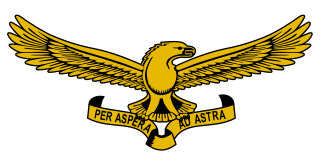
The South African Air Force (SAAF) is the air warfare branch of South African National Defence Force, with its headquarters in Pretoria. The South African Air Force was established on 1 February 1920. The Air Force saw service in World War II and the Korean War. From 1966, the SAAF was involved in providing infantry support in the low-intensity Border War in Angola, South-West Africa and Rhodesia. As the war progressed, the intensity of air operations increased, until in the late 1980s when the SAAF were compelled to fly fighter missions against Angolan aircraft in order to maintain tactical air superiority. On conclusion of the Border War in 1990, aircraft numbers were severely reduced due to economic pressures as well as the cessation of hostilities with neighbouring states.

The Denel Rooivalk is an attack helicopter manufactured by Denel Aviation of South Africa. Rooivalk is Afrikaans for "Red Falcon", which refers to the lesser kestrel. Development of the type began in 1984 by the Atlas Aircraft Corporation, its development is closely connected to the Atlas Oryx transport helicopter, both aircraft being based on the Aérospatiale SA 330 Puma and having started development at the same time.

The Atlas Oryx is a medium-sized utility helicopter ostensibly developed and manufactured by the Atlas Aircraft Corporation of South Africa. Its largest operator is the South African Air Force (SAAF), having been originally developed to fulfil their needs.
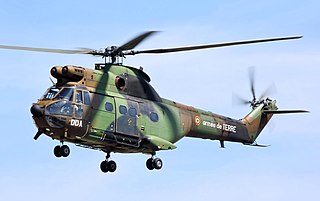
The Aérospatiale SA 330 Puma is a four-bladed, twin-engined medium transport/utility helicopter that was designed and originally produced by the French aerospace manufacturer Sud Aviation. It is capable of carrying up to 20 passengers as well as a variety of cargoes, either internally or externally; numerous armaments have also been outfitted to some helicopters.

17 Squadron SAAF is a squadron of the South African Air Force. It is currently a transport/utility helicopter squadron.
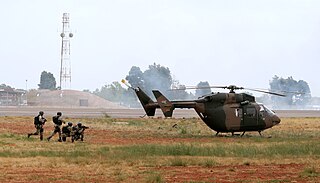
15 Squadron SAAF is a squadron of the South African Air Force. It is currently a transport/utility helicopter squadron.

19 Squadron SAAF is a current squadron of the South African Air Force operating as a transport/utility helicopter squadron. It was formed in 1939 as part of the Air Force airways Wing, flying transport aircraft but was disbanded after a few months. It was re-formed from No. 227 Squadron RAF in 1944 and disbanded again after the end of World War II. It was again re-established in 1970 as a helicopter squadron – a role which it still performs today.

Air Force Base Ysterplaat is an airbase of the South African Air Force. It is located in Cape Town suburb Ysterplaat, on the southwestern coast of South Africa. The name Ysterplaat is Afrikaans from the Dutch "Ijzerplaats", meaning "Iron Place" or "Place of Iron" in English.
The Netherlands Naval Aviation Service is the naval aviation branch of the Royal Netherlands Navy.
The Atlas Aircraft Corporation was a South African aircraft manufacturer. It was a division of the South African government-owned defence conglomerate Armaments Corporation of South Africa.
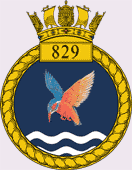
829 Naval Air Squadron was a squadron of the Royal Navy Fleet Air Arm. Before it was decommissioned in March 2018, it operated the AgustaWestland Merlin HM2 helicopter.
The South African Air Force Museum houses exhibits and restores material related to the history of the South African Air Force. The museum is divided into three locations, AFB Swartkop outside Pretoria, AFB Ysterplaat in Cape Town and at the Port Elizabeth airport.

The Pakistan Naval Air Arm is the naval aviation branch within the Pakistan Navy that is responsible for aerial operations from the seaborne platform.
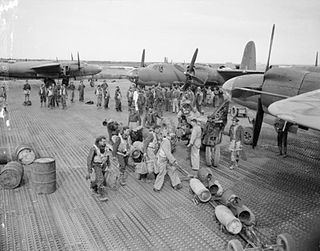
25 Squadron was a maritime patrol and later medium bomber squadron of the South African Air Force during World War II. It was re-constituted twice between 1951 and 1990 as a medium transport squadron and was finally disbanded in October 1990.
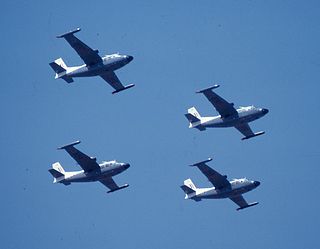
27 Squadron was established as a World War II maritime patrol squadron of the South African Air Force. It was disbanded after the war and resurrected in the same role from 1951 to 1958. Its final period of service was from 1962 to 1990 when it was finally disbanded when its Piaggio Albatross aircraft were de-commissioned.

31 Squadron was initially a World War II Coastal bomber/reconnaissance squadron South African Air Force. It was later converted to a heavy bomber squadron that operated from bases in the Mediterranean from January 1944 until the end of the war. On conclusion of hostilities, the squadron was used to ferry liberated POW's from Italy back to Britain and disbanded South African troops from Italy to Egypt. It was disbanded on 15 December 1945. It was resurrected as a medium and light helicopter squadron in 1982 and operated from AFB Hoedspruit until its final disbandment on 4 December 1992.
Southern Air Command was a formation of the South African Air Force, active from the early 1980s to the early 1990s. Throughout its existence, it had its headquarters at Silvermine, in the Cape Province.

16 Squadron SAAF is an attack helicopter squadron of the South African Air Force (SAAF). It was originally formed in World War II as a maritime patrol squadron, however, over the course of the war it was disbanded and reformed a number of times, operating a number of different types of aircraft. It was finally disbanded in June 1945 and was not re-raised until 1968 as a helicopter squadron. In the late 1980s the squadron took part in the conflict in Angola before being disbanded again in 1990. It was raised once more in 1999 and it is currently operating the Rooivalk attack helicopter.

















